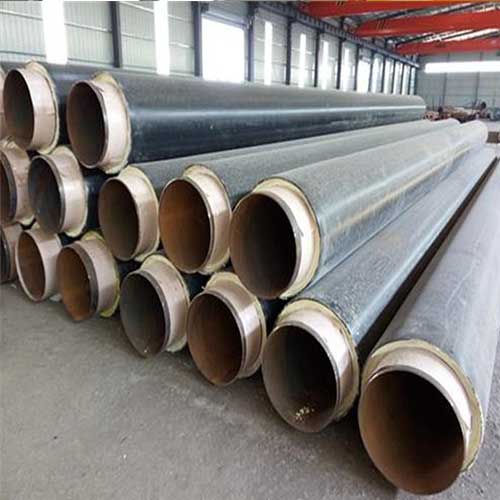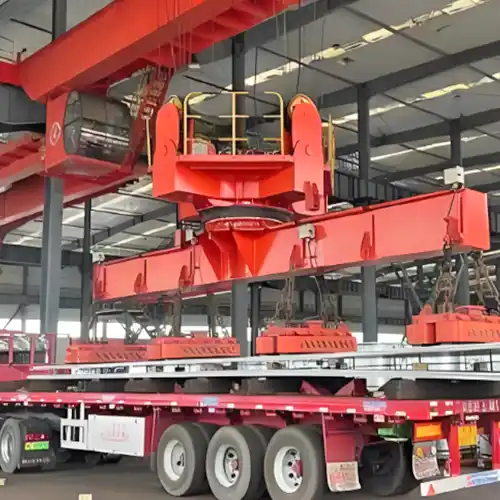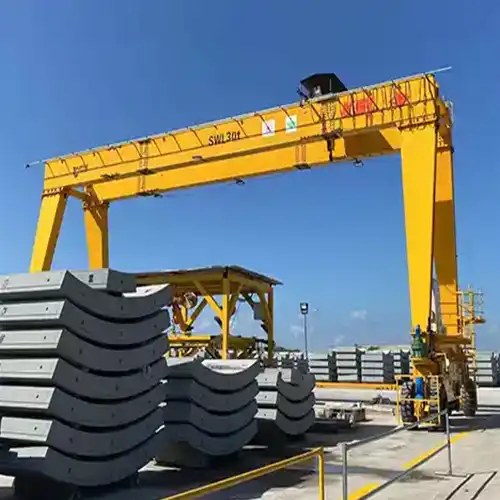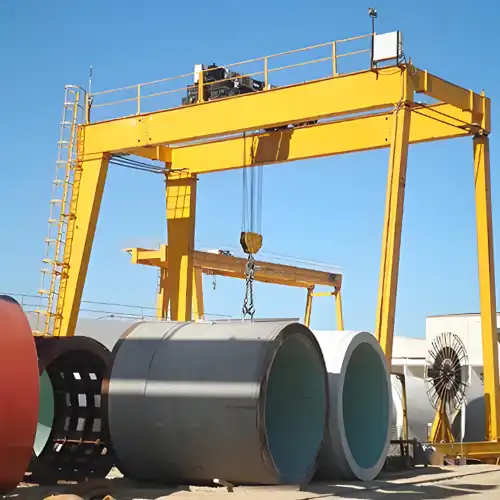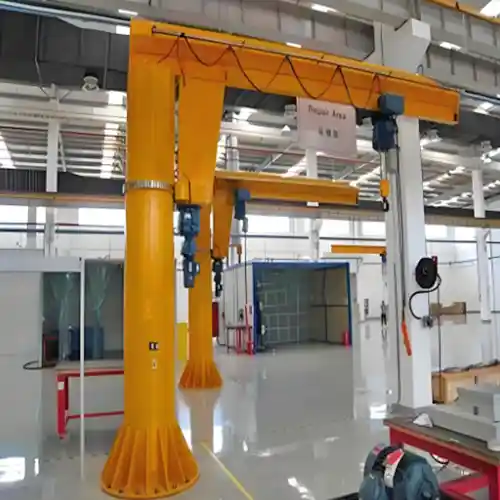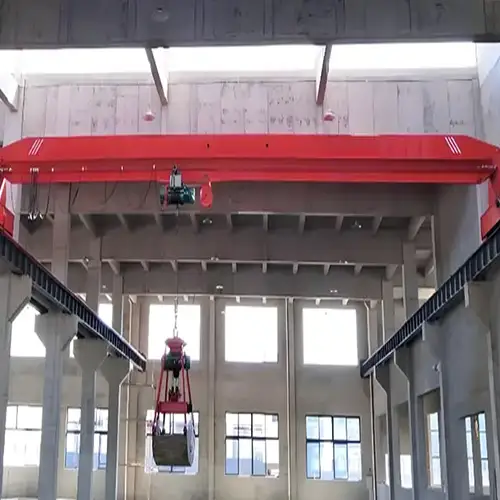Overhead Cranes for Penstock Pipe Manufacturing and Handling 1 to 50 Ton
Overhead cranes, bridge cranes, gantry cranes, jib cranes customized for all types of pendstock pipes handling in manufacturing, transportation & storage.
Category: General Manufacturing
Your Trusted Industrial Overhead Crane Manufacturer & Supplier
Overhead Cranes for Penstock Pipe Manufacturing and Handling 1 to 50 Ton
Overhead cranes, bridge cranes, gantry cranes, jib cranes customized for all types of pendstock pipes handling in manufacturing, transportation & storage.
Comprehensive Guide to Overhead Cranes for Penstock Pipe Manufacturing and Handling
Penstock pipes, an essential component in various industrial sectors, serve as conduits for transporting fluids, such as water, sewage, or chemicals. These pipes come in various materials, including steel, concrete, HDPE, and fiberglass, each tailored to meet specific project requirements. The successful manufacturing and handling of penstock pipes depend significantly on the use of appropriate equipment, particularly overhead cranes.
Overhead cranes are pivotal in the production and transportation of penstock pipes. These cranes provide the necessary lifting capacity and precision control required for moving, positioning, and installing pipes with varying diameters, weights, and materials. Whether in manufacturing facilities, construction sites, or industrial installations, overhead cranes play a critical role in ensuring the efficient and safe handling of penstock pipes.
Selecting the right overhead crane is not a one-size-fits-all endeavor. The choice of crane type, design, configuration, and attachments is crucial in ensuring the successful handling of penstock pipes. The significance of this selection process lies in optimizing efficiency, minimizing risks, and upholding the integrity of the penstock systems. A well-suited crane can contribute to improved productivity, safety, and overall project success.
Overview of Penstock Pipes
Penstock pipes are specialized conduits designed to transport various fluids, most commonly water, within a range of industrial applications. They are characterized by several key features:
- Material Diversity: Penstock pipes can be made from various materials, including steel, concrete, HDPE (High-Density Polyethylene), and fiberglass. The choice of material depends on the specific requirements of the project, such as strength, corrosion resistance, and temperature tolerance.
- Diverse Diameters: Penstock pipes come in a wide range of diameters to accommodate different flow rates and fluid viscosities. Diameters can vary from a few inches to several feet, depending on the application.
- Rugged Construction: Regardless of the material, penstock pipes are built to withstand the harsh conditions they encounter. Steel pipes are robust and durable, while HDPE and fiberglass pipes offer resistance to corrosion and wear.
- Precise Welding: For steel penstock pipes, welding plays a critical role in joining longitudinal and circumferential seams. Precise welding is essential to ensure the strength and integrity of the pipes and prevent leaks.
- Surface Coating: Steel penstock pipes often undergo surface coating with epoxy or other corrosion-resistant materials to protect against rust and corrosion, extending their lifespan.
- Quality Control: Rigorous quality control measures, including non-destructive testing (NDT), are carried out to verify the integrity of the welds and the overall quality of the pipes. This ensures the reliability of penstock systems.
Importance of Penstock Pipes in Various Industrial Sectors
Penstock pipes are integral to the success of multiple industrial sectors, including:
- Hydropower Generation: In hydropower plants, penstock pipes transport water from reservoirs or intakes to turbines, where the kinetic energy of the flowing water is harnessed to generate electricity. They are the lifeblood of hydroelectric power generation.
- Water Supply and Distribution: Municipal and industrial water supply systems rely on large-diameter penstock pipes to transport potable water from treatment plants to consumers. Ensuring the safe and efficient distribution of clean water is essential.
- Irrigation: In agriculture, large-diameter pipes distribute water to fields and crops, playing a vital role in optimizing crop yield and reducing water wastage.
- Wastewater and Sewage Management: Large-diameter pipes are essential for collecting and transporting wastewater and sewage from homes, businesses, and industrial facilities to treatment plants for processing and disposal.
- Oil and Gas Transmission: The oil and gas industry uses large-diameter pipelines to transport crude oil, natural gas, and refined petroleum products over long distances. These pipes are the backbone of energy transportation.
Key Considerations When Handling Penstock Pipes
Handling penstock pipes requires meticulous planning and the use of appropriate equipment. Key considerations include:
- Pipe Material: The material of the penstock pipe impacts its weight, corrosion resistance, and handling requirements. Steel pipes are heavier than HDPE or fiberglass pipes, necessitating different lifting solutions.
- Diameter and Length: Understanding the dimensions of the pipes is crucial for selecting the right lifting equipment and ensuring proper positioning during manufacturing and installation.
- Environmental Factors: Consider the environmental conditions in which the pipes will be handled. This includes whether the pipes are located indoors, outdoors, or in challenging environments such as hydropower plant penstocks submerged in water.
- Safety: Safety is paramount when handling large and heavy pipes. Proper training, safety protocols, and the use of reliable lifting equipment are essential for the well-being of workers and the integrity of the penstock system.
By comprehending the definition, characteristics, and significance of penstock pipes and taking key considerations into account, individuals and organizations can make informed decisions regarding the selection of overhead cranes and equipment for efficient and safe handling of these critical components.
Types of Penstock Pipes
Overview of Different Materials Used for Penstock Pipes (Steel, Concrete, HDPE, Fiberglass)
Penstock pipes come in various materials, each tailored to meet specific project requirements. Understanding the characteristics of these materials is essential for selecting the right type of penstock pipe:
Steel Penstock Pipes:
Material Selection: High-quality steel is chosen based on the project's requirements, considering factors like strength, corrosion resistance, and temperature tolerance.
Pipe Fabrication: Steel penstock pipes are typically fabricated by rolling and welding steel plates to form the desired pipe shape.
Welding: Welding is used to join the longitudinal seams and circumferential seams of the pipe sections, ensuring strength and leak-proof construction.
Heat Treatment: Heat treatment processes may be applied to improve the mechanical properties of the steel and relieve welding stresses.
Surface Coating: Steel penstock pipes are often coated with epoxy or other corrosion-resistant materials to protect against rust and corrosion.
Quality Testing: Rigorous quality control measures, including non-destructive testing (NDT), are carried out to verify the integrity of the welds and the overall quality of the pipes.
Surface Preparation: The exterior surface of the pipes may be prepared for further protective coatings.
Concrete Penstock Pipes:
Material Composition: Concrete penstock pipes are made from high-strength concrete mixed with reinforcing materials such as steel or fiber. The concrete mix is designed to withstand hydraulic pressure.
Precasting: Concrete pipes are typically precast in sections and assembled on-site. Precasting allows for consistent quality and precise manufacturing.
Surface Finish: The interior of concrete penstock pipes may be smoothed and sealed to minimize friction and improve flow characteristics.
Reinforcement: Steel reinforcement is often used to enhance the structural integrity of the concrete pipes.
HDPE (High-Density Polyethylene) Penstock Pipes:
Material Properties: HDPE is a lightweight and durable plastic material known for its corrosion resistance and flexibility.
Extrusion Process: HDPE penstock pipes are typically manufactured through the extrusion process, where molten HDPE is forced through a die to create the pipe shape.
Jointing Methods: HDPE pipes can be joined using various methods, including butt fusion, electrofusion, and mechanical couplings.
Corrosion Resistance: HDPE is highly resistant to corrosion and is suitable for applications where chemical resistance is required.
Fiberglass Reinforced Penstock Pipes:
Material Composition: Fiberglass penstock pipes consist of layers of fiberglass fabric impregnated with resin. This composite material offers excellent strength and corrosion resistance.
Lamination Process: The lamination process is used to create the pipe structure, where layers of fiberglass and resin are bonded together and cured.
Customization: Fiberglass pipes can be customized with additional layers or coatings to meet specific project requirements.
Specific Requirements and Challenges Associated with Each Material
Steel pipes require careful welding and surface coating to prevent corrosion.
Concrete pipes need precise precasting and surface finishing.
HDPE pipes require proper jointing techniques for leak-free connections.
Fiberglass pipes offer high corrosion resistance but may have specific customization requirements.
Application Areas for Different Penstock Pipe Types
Steel penstock pipes are often used in hydropower generation and water supply systems.
Concrete penstock pipes are common in hydropower and water distribution.
HDPE penstock pipes find application in water supply, irrigation, and chemical transport.
Fiberglass reinforced penstock pipes are suitable for environments with aggressive chemicals or corrosive conditions.
Selecting the right penstock pipe material depends on the specific project needs and environmental factors, which further underscores the importance of choosing the appropriate overhead crane for handling these varied pipe types.
Overhead Crane Types for Penstock Pipe Handling
When it comes to handling penstock pipes, the selection of the appropriate overhead crane type is pivotal. Various crane types are available, each offering distinct features and capabilities. Understanding these crane types and their applications is essential for efficient penstock pipe handling.

Design:
Single girder bridge cranes including top running crane and underhung bridge crane, feature a single horizontal beam running along the top of the facility, supported by end trucks.
Configuration:
Suitable for light to moderate penstock pipe handling, offering a cost-effective solution.
Ideal for smaller pipes and less complex manufacturing or installation processes.
Attachments:
Common lifting attachments include hooks, slings, or specialized devices designed for various pipe materials and sizes.
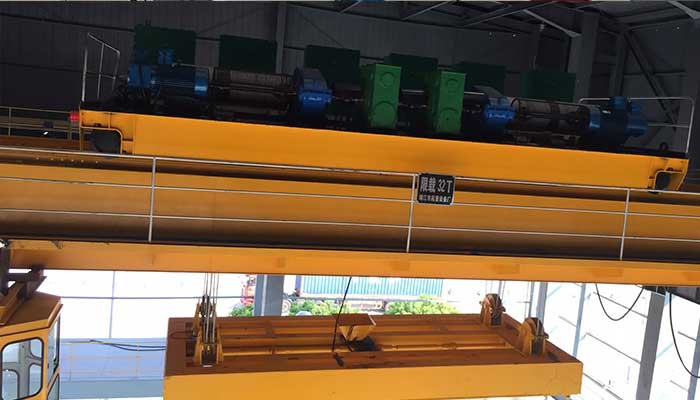
Design:
Double girder bridge cranes feature two parallel horizontal beams, providing increased stability and lifting capacity.
Configuration:
Ideal for heavy-duty penstock pipe manufacturing and handling, especially for larger and heavier pipes.
Well-suited for projects where precision control and high load capacity are essential.
Attachments:
Various lifting devices, such as hooks, spreader beams, or custom lifting devices, can be used with double girder cranes to handle penstock pipes effectively.
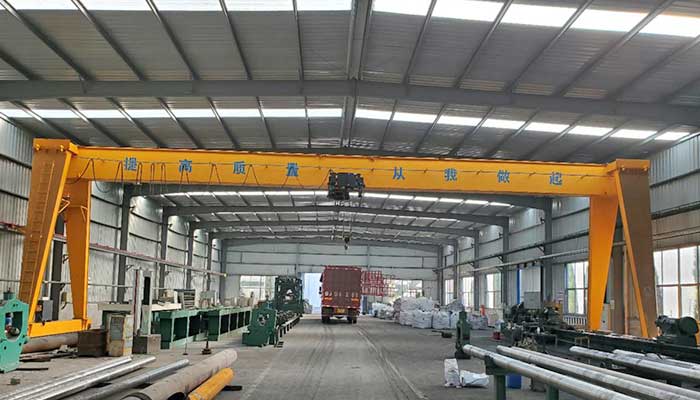
Gantry Cranes
Design:
Gantry cranes including semi gantry crane, single girder gantry crane and double girder gantry cranes are similar to bridge cranes but are supported by legs or vertical posts and run on rails at ground level.
Configuration:
Suitable for outdoor or semi-outdoor applications, offering versatility for penstock pipe handling in various environments.
Available in both single and double girder configurations, providing flexibility in crane selection.
Attachments:
Lifting devices like slings, hooks, and spreader beams can be used with gantry cranes to handle penstock pipes of different materials and sizes.
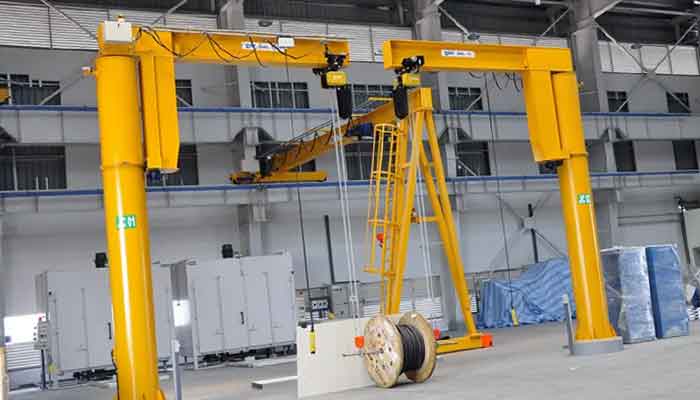
Jib Cranes
Design:
Jib cranes have a vertical post or mast with a horizontal boom, providing rotation and lifting capabilities.
Configuration:
Wall-mounted or freestanding jib cranes can be used, depending on the layout of the manufacturing facility or construction site.
Suited for applications where localized lifting and positioning are required.
Attachments:
Jib crane attachments may include hoists, hooks, or custom lifting devices designed to handle penstock pipes with precision.
Functions of Overhead Cranes for Pendstock Pipe Handling
Overhead cranes play a crucial role in penstock pipe manufacturing and handling, as they are responsible for safely moving, positioning, and installing these large and heavy pipes. Their functions and uses during penstock pipe manufacturing and handling include:
General Functions and Uses of Overhead Cranes:
- Lifting and Lowering: Overhead cranes are used to lift penstock pipes from storage or fabrication areas and lower them into their designated positions.
- Transport: Cranes are employed to transport penstock pipes within the manufacturing facility, from one location to another, or from the production area to the installation site.
- Precise Positioning: Overhead cranes offer precise control for accurately positioning penstock pipes during installation, ensuring they align correctly with other components.
- Rotation and Orientation: Some cranes are equipped with specialized attachments that can rotate and orient the pipes to the desired angle, ensuring proper alignment.
- Handling Multiple Pipes: Cranes can handle multiple pipes simultaneously, improving efficiency during assembly or installation processes.
- Installation and Assembly: Overhead cranes are essential for the installation and assembly of penstock pipes, including connecting pipes, fittings, and other components.
Features and Benefits of Overhead Cranes
Overhead cranes offer a range of features and benefits that make them indispensable for penstock pipe manufacturing and handling. Understanding these advantages can help project managers and operators make informed decisions when selecting the right crane for their specific requirements.
High Lifting Capacity -One of the primary advantages of overhead cranes is their exceptional lifting capacity. These cranes are designed to handle heavy loads, making them well-suited for the transportation and positioning of large and weighty penstock pipes. Whether it's steel, concrete, HDPE, or fiberglass pipes, overhead cranes can efficiently manage the lifting and moving of these materials.
Precision Control and Positioning -Overhead cranes are equipped with precise control systems that enable operators to accurately position penstock pipes. This level of control is essential for aligning pipes during manufacturing processes and ensuring precise installation in complex industrial projects. It minimizes the risk of damage and enhances overall efficiency.
Durability and Reliability -Overhead cranes are built to withstand the rigors of industrial use. They are constructed from robust materials and components that ensure long-term durability and reliability. This is especially important in projects with high-duty cycles and heavy loads.
Safety Features -Safety is a top priority when handling penstock pipes. Overhead cranes come with a range of safety features, including limit switches, overload protection, emergency stop systems, and collision avoidance mechanisms. These safety measures protect both the equipment and the workers involved in the handling process.
Adaptability and Customization -Overhead cranes can be customized to meet specific project requirements. Whether it's adapting the lifting attachments, adding automation features, or tailoring the crane's design, customization options are available to ensure the crane aligns perfectly with the needs of the application.
Increased Productivity and Reduced Manual Labor -The use of overhead cranes significantly increases productivity in penstock pipe manufacturing and handling. These cranes can perform tasks quickly and efficiently, reducing the reliance on manual labor. This not only boosts productivity but also minimizes the physical strain on workers.
In summary, overhead cranes are an indispensable asset in penstock pipe manufacturing and handling due to their high lifting capacity, precision control, durability, safety features, adaptability, and the overall efficiency they bring to industrial processes. The selection of the right crane with these features can greatly contribute to the success of projects in various industrial sectors.
Applications of Overhead Cranes for Penstock Pipes
Overhead cranes find extensive applications in the handling of penstock pipes across a range of settings and industries. Understanding these applications is essential for selecting the right crane for the specific project needs.

Manufacturing Facilities
Overhead cranes are commonly used in manufacturing facilities where penstock pipes are produced. These cranes aid in the fabrication and assembly of penstock pipes, allowing for precise positioning during welding, surface treatment, and quality control processes. They streamline the manufacturing workflow, ensuring that pipes are built to exact specifications.
Installation at Construction Sites
Construction sites, especially in hydropower and environmental restoration projects, rely on overhead cranes for the installation of penstock pipes. Overhead cranes make it possible to lift and position large and heavy pipes with precision, ensuring they are securely placed in their designated locations. This is crucial for the success of construction projects involving penstock pipes.
Overhead Crane for Specific Industrial Sectors
Hydroelectric Power Generation:
Penstock pipes are a critical component of hydroelectric power plants. They transport water from a reservoir or intake to the turbines, where the energy of the flowing water is converted into electricity.
Overhead Crane Type: Bridge cranes, both single and double girder, are commonly used to handle penstock pipes in hydroelectric power plants. These cranes offer high lifting capacity and precise control for pipe positioning.
Typical Capacity: The crane capacity depends on the size and weight of the penstock pipes, which can range from a few tons to over 100 tons.
Overhead Crane Functions and Applications: These cranes are used for the safe and efficient handling of penstock pipes, including installation, maintenance, and positioning. They ensure precise placement of pipes to maximize power generation.
Features and Benefits: Overhead cranes in hydroelectric power plants are engineered for reliability and precision. They can be customized to meet the specific requirements of each project, ensuring safe and efficient handling of penstock pipes.
Water Supply and Distribution:
Large-diameter pipes are used in municipal and industrial water supply systems to transport potable water from water treatment plants to consumers.
Overhead Crane Type: Bridge cranes, gantry cranes, or jib cranes may be used for handling and installation of water supply pipes.
Typical Capacity: Capacities vary based on the pipe size and installation requirements, typically ranging from a few tons to 20 tons or more.
Overhead Crane Functions and Applications: These cranes facilitate the safe transport, installation, and maintenance of large-diameter water pipes in water supply and distribution systems.
Features and Benefits: Overhead cranes used in this sector are designed to withstand exposure to water and other environmental conditions. They offer precise control for precise pipe placement.
Irrigation:
Agricultural irrigation systems use large-diameter pipes to distribute water to fields and crops.
Overhead Crane Type: Bridge cranes, gantry cranes, or jib cranes may be employed for handling and installing irrigation pipes.
Typical Capacity: Usually ranging from a few tons to 10 tons or more, depending on the size and weight of the pipes.
Overhead Crane Functions and Applications: Overhead cranes in irrigation systems assist in the movement, positioning, and installation of irrigation pipes to ensure efficient water distribution for agriculture.
Features and Benefits: These cranes are designed for durability and efficiency, supporting the needs of agricultural irrigation systems.
Wastewater and Sewage:
Large-diameter pipes are essential for the collection and transport of wastewater and sewage from homes, businesses, and industrial facilities to treatment plants.
Overhead Crane Type: Bridge cranes or jib cranes are commonly used for handling and installing wastewater and sewage pipes.
Typical Capacity: Typically from a few tons to 20 tons or more, depending on the pipe size and the facility.
Overhead Crane Functions and Applications: Overhead cranes play a crucial role in the installation and maintenance of pipes in wastewater and sewage systems, ensuring proper waste disposal and treatment.
Features and Benefits: These cranes are designed for safety and efficiency, with materials and coatings that can withstand the harsh and corrosive wastewater environment. They also offer precise control for accurate pipe placement.
Oil and Gas Transmission:
In the oil and gas industry, large-diameter pipelines are used to transport crude oil, natural gas, and refined petroleum products over long distances.
Overhead Crane Type: Heavy-duty bridge cranes or gantry cranes are often used for the installation and maintenance of pipelines in the oil and gas sector.
Typical Capacity: Capacities may range from 20 tons to over 100 tons, depending on the pipeline size and weight.
Overhead Crane Functions and Applications: Overhead cranes assist in the safe and efficient handling, installation, and maintenance of pipelines in the oil and gas transmission sector.
Features and Benefits: These cranes are designed for heavy lifting and can be equipped with specialized features to meet the industry's stringent safety and environmental standards.
Stormwater Management:
Large-diameter pipes can be used in stormwater management systems to transport rainwater runoff away from urban areas to prevent flooding.
Overhead Crane Type: Bridge cranes, gantry cranes, or jib cranes may be used for handling and installation of pipes in stormwater management projects.
Typical Capacity: Capacities usually range from a few tons to 20 tons, depending on the pipe size and project requirements.
Overhead Crane Functions and Applications: These cranes facilitate the installation and maintenance of stormwater management infrastructure, including pipes for drainage and flood control.
Features and Benefits: Overhead cranes in this sector are designed for versatility and durability, with precise controls for accurate positioning.
Mining and Slurry Transport:
In mining operations, large-diameter pipes are used to transport slurry (a mixture of water and crushed ore) from mining sites to processing facilities.
Overhead Crane Type: Heavy-duty bridge cranes or gantry cranes are employed for handling and installing pipes in mining and slurry transport applications.
Typical Capacity: Capacities can range from 20 tons to over 100 tons, depending on the pipeline size and weight.
Overhead Crane Functions and Applications: These cranes play a vital role in moving and maintaining the pipes used for transporting slurry in mining operations.
Features and Benefits: Overhead cranes in the mining sector are designed for rugged use and can be customized with specialized attachments for handling heavy and abrasive materials.
Geothermal Energy:
In geothermal power generation, large-diameter pipes may be used to carry hot water or steam from underground reservoirs to power plants.
Overhead Crane Type: Specialized bridge or gantry cranes designed for high-temperature environments may be utilized.
Typical Capacity: Capacities vary but often range from a few tons to 20 tons or more.
Overhead Crane Functions and Applications: These cranes assist in the safe handling and installation of pipes used in geothermal power generation.
Features and Benefits: Overhead cranes for geothermal applications are designed for reliability in high-temperature environments and can be customized for specific needs.
Chemical Processing:
In chemical and industrial facilities, large-diameter pipes are used for the transport of chemicals and other process fluids.
Overhead Crane Type: Bridge cranes are commonly used for handling and positioning pipes in chemical processing facilities.
Typical Capacity: Capacities may vary, typically ranging from a few tons to 20 tons or more, depending on the pipe size.
Overhead Crane Functions and Applications: These cranes are essential for the safe handling and precise placement of pipes used in chemical processes.
Features and Benefits: Overhead cranes in chemical processing are often equipped with chemical-resistant coatings and materials, ensuring safe and precise material handling.
Cooling Water Systems:
Some industrial facilities, such as power plants and manufacturing plants, use large-diameter pipes for cooling water systems to dissipate excess heat.
Overhead Crane Type: Bridge cranes, gantry cranes, or specialized overhead cranes may be used for the installation and maintenance of large-diameter cooling water pipes.
Typical Capacity: Capacities depend on the size and weight of the cooling water system components and can vary significantly.
Overhead Crane Functions and Applications: These cranes assist in the movement, positioning, and installation of cooling water system components.
Features and Benefits: Overhead cranes for cooling water systems are designed for heavy-duty use and can be customized for specific cooling system requirements.
Environmental and Flood Control:
Large-diameter pipes can be used in environmental restoration and flood control projects to manage water flow and control erosion.
Overhead Crane Type: Depending on the specific task, various types of bridge cranes, gantry cranes, or specialized cranes may be used.
Typical Capacity: Capacities vary based on the materials to be handled and the specific requirements of the project.
Overhead Crane Functions and Applications: Overhead cranes are used for handling materials and pipes involved in environmental and flood control projects, ensuring proper management of water flow.
Features and Benefits: These cranes are designed for versatility, enabling them to handle a range of materials encountered in environmental and flood control applications. Customizations may include specialized attachments.
Pulp and Paper Industry:
In pulp and paper manufacturing, large-diameter pipes are used for the transport of water, chemicals, and pulp throughout the production process.
Overhead Crane Type: Bridge cranes are often used for handling pipes, chemicals, and other components in the pulp and paper industry.
Typical Capacity: Capacities may vary, typically ranging from a few tons to 20 tons or more, depending on the material handling requirements.
Overhead Crane Functions and Applications: These cranes facilitate the movement and precise placement of materials and components used in pulp and paper manufacturing.
Features and Benefits: Overhead cranes in the pulp and paper industry are designed for precision, as accurate positioning is critical to the manufacturing process. They may also have specialized hooks or lifting devices for efficient material handling.
In each of these sectors, overhead cranes are customized to meet the specific needs and requirements of the industry, ensuring safe, efficient, and precise handling of penstock pipes and other materials. Customization may include variations in crane type, capacity, and features tailored to the unique demands of each application.
Selection Criteria for Choosing the Right Crane Type
Selecting the right crane type for penstock pipe handling is determined by several crucial factors:
- Load Capacity: The weight of the penstock pipes being handled is a primary consideration. Heavy pipes require cranes with higher load capacities, such as double girder bridge cranes.
- Project Scope: The scope of the project, including the size and number of penstock pipes, affects the choice of crane type. Larger projects may necessitate more robust cranes.
- Environmental Conditions: Consider whether the crane will be used indoors or outdoors and in what type of environment. Gantry cranes are suitable for outdoor use, while indoor facilities may use bridge cranes or jib cranes.
- Precision Requirements: Some projects demand precise control and positioning of penstock pipes. Double girder bridge cranes are often chosen for applications where accuracy is paramount.
- Customization Needs: Specialized lifting devices or custom solutions may be required to handle penstock pipes with unique dimensions or materials.
- Budget Constraints: Budget considerations play a role in crane selection. Single girder bridge cranes are a cost-effective choice for many projects.

By evaluating these selection criteria and understanding the capabilities of each crane type, project managers and operators can make informed decisions when choosing the right crane for efficient penstock pipe manufacturing and handling.
Crane Design and Configuration Considerations
Overhead crane customized based on your penstock pipe specifications
The typical diameters, lengths, and weights of penstock pipes used in different applications can vary widely based on the specific requirements of each project, the flow rates, and the head (vertical drop) involved. Here are some general guidelines for penstock pipe characteristics, but it's important to note that there is no one-size-fits-all answer, as these specifications are highly dependent on the particular hydroelectric project or water management application:
Diameter:
Small to Medium Applications: Penstock pipes for small to medium-sized hydroelectric power plants or water management systems may have diameters ranging from 12 inches (30 cm) to 48 inches (120 cm).
Large Hydroelectric Projects: Larger hydroelectric projects may require penstock pipes with diameters of 60 inches (150 cm) or more.
Length:
Penstock pipes can vary significantly in length based on the distance between the water source (e.g., the reservoir or intake) and the turbine or power generation unit. Lengths can range from a few meters to several kilometers.
Weight:
The weight of penstock pipes is influenced by their material, diameter, and wall thickness. Smaller pipes may weigh a few tons, while larger and thicker-walled pipes can weigh tens or hundreds of tons.
Material:
Steel Penstock Pipes: Steel penstock pipes are commonly used and can vary in weight and thickness based on the specific application. They are known for their durability and strength.
Concrete Penstock Pipes: Concrete penstock pipes are used for specific applications and can be quite heavy due to the density of concrete.
HDPE Penstock Pipes: High-density polyethylene (HDPE) pipes are lighter than steel or concrete and are often used in smaller applications or where corrosion resistance is essential.
Pressure Rating:
The pressure rating of the penstock pipe will influence the wall thickness and, consequently, the weight of the pipe. Higher-pressure applications require thicker-walled pipes.
Coating and Lining:
Depending on the material and the environmental conditions, penstock pipes may have various coatings or linings, which can add some weight and thickness.
It's important to consult with engineers, hydroelectric specialists, and manufacturers to determine the exact specifications for penstock pipes for a particular project. The design and sizing of penstock pipes are critical to ensure they can safely handle the flow of water and meet the requirements of the hydroelectric or water management application. Additionally, factors like the location, local regulations, and environmental considerations will also influence the choice of penstock pipe specifications.
Parameters of Overhead Cranes Needed to Customize your overhead cranes
Selecting the right overhead crane for penstock pipe manufacturing and handling involves several critical design and configuration considerations. These factors are essential to ensure that the chosen crane aligns with the specific requirements of the project.

Crane Span and Lifting Height
- Crane Span: The span refers to the distance between the crane's runway rails or supports. It is crucial to determine the appropriate span to cover the entire area where penstock pipes need to be handled. A wider span may be required for larger facilities or outdoor settings.
- Lifting Height: The lifting height defines how high the crane's hook or lifting attachment can reach. It must accommodate the vertical requirements of the project, including the height of storage, assembly, or installation areas. It is important to have a crane with adequate lifting height to ensure pipes can be maneuvered without obstructions.
Load Capacity and Duty Cycle
- Load Capacity: Determining the maximum load capacity is paramount. The crane's load capacity should comfortably exceed the weight of the heaviest penstock pipe to be handled. It's essential to consider any potential variations in load weight, including factors like lifting equipment and pipe accessories.
- Duty Cycle: The duty cycle indicates the crane's expected usage and operating hours. Projects with continuous or heavy-duty requirements will need cranes designed for high-duty cycles to maintain reliability and longevity.
Customization Options for Specific Applications
- Customization: Crane manufacturers often provide customization options to tailor the crane to the specific requirements of the application. This may include modifications to the lifting attachments, controls, or additional safety features. Customization is particularly valuable when handling unique pipe sizes, materials, or working environments.
Indoor and Outdoor Considerations
- Indoor Applications: For indoor applications, it is important to ensure that the crane's size, design, and emissions meet indoor regulations and can navigate through existing structures, doorways, and work areas.
- Outdoor Applications: Outdoor environments present additional challenges, including exposure to weather conditions. Gantry cranes are often chosen for outdoor use due to their structural stability and mobility. It is important to select a crane with appropriate weather-resistant features and protective coatings for outdoor applications.
Crane Controls and Automation Features
- Control Systems: Consider the type of control system that best suits the project. Manual controls are suitable for simpler operations, while more complex projects may benefit from radio remote controls or cabin control for precise maneuvering.
- Automation Features: Modern overhead cranes may come with automation features like load monitoring, collision avoidance systems, and advanced safety mechanisms. These features can enhance operational efficiency and safety, especially in high-volume manufacturing environments.
By carefully evaluating these design and configuration considerations, project managers and operators can make well-informed decisions about the selection and customization of overhead cranes for penstock pipe manufacturing and handling. These choices are essential to ensure the safety, efficiency, and success of the project.
Crane Attachments and Below-Hook Devices
Effective penstock pipe handling often relies on the use of appropriate lifting attachments and below-hook devices. These components are critical for securing, lifting, and positioning penstock pipes safely and efficiently.
Overview of Common Lifting Attachments
- Hooks: Hooks are versatile and commonly used for lifting various materials, including penstock pipes. They can be equipped with safety latches to prevent accidental unhooking.
- Slings: Slings are flexible and adaptable for different pipe sizes and materials. They come in various configurations, such as wire rope slings, chain slings, and synthetic web slings.
- Grabs: Grabs are suitable for handling pipes with irregular shapes or surfaces. They can grip the pipe securely and release it as needed.
- Tongs: Tongs are designed to grip cylindrical objects, making them suitable for penstock pipes. They can be adjusted to accommodate different pipe diameters.
- Vacuum Lifters: Vacuum lifters use suction cups to securely hold non-porous surfaces. While they are suitable for some penstock pipe materials, compatibility should be confirmed.
- Spreader Beams: Spreader beams distribute the load evenly across multiple lifting points. They are ideal for long and heavy pipes.
Selection of Attachments Based on Penstock Pipe Material and Dimensions
The choice of lifting attachment depends on the material and dimensions of the penstock pipes:
- Steel Pipes: Steel pipes may be handled with hooks, slings, or grabs, depending on the shape and size. Heavy-duty hooks are suitable for larger steel pipes, while slings provide flexibility for various sizes.
- Concrete Pipes: Lifting attachments for concrete pipes may include specialized tongs or clamps designed to securely grip the cylindrical shape without damaging the pipe's surface.
- HDPE Pipes: HDPE pipes are typically lightweight and require specialized lifting attachments that prevent deformation or damage to the pipe's walls. Vacuum lifters or custom clamps may be used.
- Fiberglass Pipes: Fiberglass pipes are fragile compared to steel or concrete. Customized lifting devices that distribute the load evenly without causing stress or damage are recommended.
Custom Lifting Devices for Specialized Applications
Some projects may require customized lifting devices to address unique challenges. These specialized devices can be designed to accommodate non-standard pipe shapes, sizes, or materials. For instance:
- Non-Cylindrical Pipes: Pipes with irregular shapes may require custom tongs, grabs, or clamps to ensure a secure grip during lifting.
- Large-Diameter Pipes: Specialized spreader beams or lifting frames can be designed to distribute the load evenly across the length of large-diameter pipes.
- Corrosive Environments: In environments where pipes may be exposed to corrosive substances, custom lifting devices with protective coatings or materials may be necessary.
- Fragile Materials: When handling fragile materials like fiberglass, custom lifting devices should provide even weight distribution and minimize the risk of damage.

The selection of lifting attachments and below-hook devices is a critical component of safe and efficient penstock pipe handling. Customization may be required to address the specific challenges presented by different pipe materials and project requirements.
Customization and Special Requirements
Customization and addressing special requirements are critical aspects of selecting overhead cranes for penstock pipe manufacturing and handling. These considerations ensure that the crane aligns perfectly with the project's unique demands.
Meeting Unique Project Specifications
Every project involving penstock pipes comes with specific requirements that may differ from one another. These unique project specifications can encompass factors like the size and weight of penstock pipes, the material of the pipes, and the layout of the manufacturing or installation area. Overhead cranes must be tailored to meet these project-specific requirements, which may involve:
- Custom Lifting Attachments: Designing lifting attachments or below-hook devices that are specifically suited to handle the penstock pipes in question.
- Adjusting Load Capacity: Ensuring that the crane's load capacity aligns with the weight of the heaviest pipes to be handled during the project.
- Modifying Crane Span: Customizing the crane's span to cover the entire work area or installation site.
- Adapting Lifting Height: Adjusting the crane's lifting height to accommodate the vertical requirements of the project.
Compliance with Industry Standards and Regulations
Industrial projects, particularly in sectors like hydropower, oil and gas, or environmental restoration, must adhere to industry standards and regulations to ensure safety and quality. Overhead cranes used in these projects should be designed and configured to comply with these standards. This may involve:
- Load Testing: Conducting load tests to verify that the crane can safely handle the expected loads in accordance with industry standards.
- Certifications: Ensuring that the crane and its components have the necessary certifications and approvals to operate in the specific industrial sector.
- Safety Features: Incorporating additional safety features and mechanisms to meet or exceed industry safety requirements.
Addressing Environmental Considerations
Some projects may involve environmental considerations, such as working in sensitive ecosystems or managing hazardous materials. Overhead cranes must be customized to address these environmental factors, including:
- Weather Resistance: When working in outdoor settings, cranes should be equipped with weather-resistant features to withstand exposure to rain, wind, and extreme temperatures.
- Corrosion Protection: In projects where pipes are exposed to corrosive substances, cranes should have protective coatings and materials to prevent damage.
- Environmental Impact: Considering the environmental impact of crane operations and implementing measures to minimize disturbance to ecosystems or communities.
Addressing customization and special requirements is essential to ensure the successful and safe completion of projects involving penstock pipe manufacturing and handling. By tailoring overhead cranes to meet unique specifications and environmental considerations, project managers can enhance the efficiency and reliability of their operations.
Selection and Procurement Process
Selecting the right overhead crane for penstock pipe manufacturing and handling is a comprehensive process that involves several key steps to ensure the crane aligns with the project's needs and specifications.
Identifying Project Requirements
- Define Project Scope: Begin by clearly defining the scope of the project, including the number of penstock pipes to be handled, their sizes and weights, the layout of the manufacturing or installation area, and any unique project specifications.
- Determine Load Capacity: Identify the weight of the heaviest penstock pipe that needs to be handled. Ensure the crane's load capacity exceeds this weight.
- Consider Environmental Factors: Evaluate the project's environmental considerations, such as indoor or outdoor operation, exposure to weather, and any potential exposure to corrosive substances.
Consulting with Crane Manufacturers and Suppliers
- Research and Shortlist Manufacturers: Research reputable overhead crane manufacturers and suppliers with experience in penstock pipe handling applications. Shortlist those with a track record of delivering cranes that meet industry standards and regulations.
- Consult with Experts: Engage in consultations with crane experts and engineers from the shortlisted manufacturers. Discuss the project's specific requirements, challenges, and environmental factors to gain insight into suitable crane solutions.
- Review Customization Options: Inquire about the customization options available to tailor the crane to the project's unique needs, including custom lifting attachments, controls, and additional safety features.
Requesting Quotes and Proposals
- Request Quotes: Ask the shortlisted manufacturers to provide detailed quotes for the overhead crane, including costs for design, fabrication, customization, delivery, and installation. Ensure that the quotes itemize all expenses.
- Evaluate Proposals: Review the proposals provided by the manufacturers, which should outline the crane's design, configuration, and any customization options. Assess how well each proposal aligns with the project's requirements.
- Consider Lead Times: Take lead times into account to ensure that the crane can be delivered within the project's timeline. Delays in crane procurement can impact the overall schedule.
Evaluating Options and Making an Informed Decision
- Compare Options: Compare the quotes and proposals from different manufacturers. Consider factors like load capacity, customization capabilities, compliance with industry standards, and the overall value offered by each option.
- Review References and Case Studies: Request references and case studies from the manufacturers to assess their past performance in similar projects. Contact previous clients to gain insights into the quality and reliability of their products.
- Evaluate After-Sales Support: Consider the after-sales support provided by the manufacturer, including maintenance and repair services. Reliable support is essential for the long-term operation of the crane.
- Make an Informed Decision: After careful evaluation, select the manufacturer and overhead crane that best align with the project's requirements, budget constraints, and timeline. Ensure that the chosen crane meets safety standards and is capable of handling penstock pipes efficiently.
The selection and procurement process for overhead cranes is a vital step in the success of penstock pipe manufacturing and handling projects. By following this comprehensive process, project managers can make informed decisions and ensure that the chosen crane meets all the project's specific requirements.
Maintenance and Safety
Ensuring the ongoing safety and efficiency of overhead cranes used in penstock pipe manufacturing and handling is crucial. This section covers maintenance procedures, safety protocols, and the significance of proper training.
Regular Maintenance and Inspection Procedures
- Scheduled Maintenance: Implement a routine maintenance schedule to inspect and service the crane components. Regular maintenance helps prevent equipment failures and ensures the crane's longevity.
- Inspection Checklist: Develop a comprehensive inspection checklist covering critical components like hoists, hooks, cables, electrical systems, and safety mechanisms. Regularly review and update this checklist.
- Wear and Tear: Address any signs of wear and tear promptly. Replacing worn-out components, such as cables or hooks, is essential to maintain crane reliability.
- Lubrication: Properly lubricate moving parts to reduce friction and extend their lifespan. Regular lubrication prevents premature component failures.
- Testing and Load Checks: Conduct periodic load tests and checks to verify that the crane can safely handle the maximum load capacity. These tests ensure that the crane remains within safety parameters.
Safety Protocols for Crane Operation and Pipe Handling
- Operator Training: Ensure that crane operators undergo comprehensive training and certification. Competent operators are essential for safe and efficient crane operation.
- Load Limits: Adhere to load capacity limits at all times. Overloading the crane poses a significant safety risk and can lead to equipment failure.
- Clear Communication: Establish clear communication protocols between the crane operator and ground personnel involved in pipe handling. Effective communication prevents accidents and mismanagement.
- Emergency Procedures: Develop and communicate emergency procedures for situations like power outages, equipment malfunctions, or accidents. Crane operators and staff should be well-versed in these procedures.
- Fall Protection: Implement fall protection measures for personnel working at heights while installing or handling penstock pipes. Fall protection equipment and protocols are essential for worker safety.
- Safe Hooking and Unhooking: Train personnel in proper hooking and unhooking techniques to prevent accidents during pipe lifting and positioning.
- Safety Barriers: Implement safety barriers and signage to create safe zones around crane operation areas, preventing unauthorized access.
Importance of Training and Operator Competence
- Continuous Training: Provide ongoing training to crane operators to ensure they remain up to date with the latest safety practices, crane features, and industry standards.
- Certification: Encourage operators to obtain relevant certifications and licenses that demonstrate their competence in crane operation.
- Operator Competence: Competent crane operators are not only skilled in crane operation but also well-versed in safety practices and emergency response. Operator competence is essential for both safety and productivity.
- Staff Awareness: Ensure that all personnel working in proximity to crane operations are aware of the potential risks and safety procedures. A safety-conscious work environment is crucial for accident prevention.
Safety and maintenance are paramount in the operation of overhead cranes used for penstock pipe manufacturing and handling. By adhering to strict safety protocols, implementing regular maintenance, and ensuring operator competence, project managers can significantly reduce the risks associated with crane operations and contribute to the overall success of their projects.
Insights from Pipe Manufacturers and Users
- Pipe Manufacturer's Perspective: A leading penstock pipe manufacturer shared insights into the benefits of collaborating with crane manufacturers to design customized lifting attachments. This partnership resulted in more efficient and safer manufacturing processes, reducing the risk of damage to the pipes.
- User's Testimonial: A user from a water supply utility praised the selection of a specific type of overhead crane for their installation projects. This crane's precision control allowed for the accurate alignment of pipes, minimizing the need for adjustments and ensuring a reliable water supply to consumers.
- Hydropower Plant Operator's Experience: An operator of a hydropower plant emphasized the significance of selecting overhead cranes with high load capacities. These cranes were instrumental in managing the transport of steel penstock pipes and related components, contributing to the plant's operational efficiency and power generation.
These case studies and insights underscore the importance of thoughtful overhead crane selection in penstock pipe manufacturing and handling. They provide real-world examples of how the right crane choice can lead to successful project outcomes, improved efficiency, and enhanced safety.
Conclusion
In conclusion, this comprehensive guide has explored the vital role of overhead cranes in penstock pipe manufacturing and handling. It has provided valuable insights into the selection, customization, and safe operation of cranes in a wide range of industrial sectors.
The significance of selecting the right overhead crane cannot be overstated. The efficiency, safety, and success of projects involving penstock pipe manufacturing and handling hinge on this choice. The proper crane selection ensures the seamless transportation, positioning, and installation of penstock pipes, regardless of their material, size, or application.
We encourage all readers, whether they are pipe manufacturers, project managers, or operators, to make informed decisions when selecting overhead cranes for penstock pipe handling. By carefully considering project requirements, customization options, safety protocols, and maintenance procedures, you can enhance the overall success of your projects and contribute to a safer and more efficient work environment.
Choosing the right overhead crane is not just a business decision; it's a commitment to quality, safety, and the successful completion of projects that play a crucial role in various industrial sectors. Your informed choices matter, and they make a difference in the world of penstock pipes.
Main Projects
Related Products

Supplied three grab bucket crane kits to Indonesia, enhancing garbage handling efficiency with high load capacity and reliable performance.
Free consultation to Confirm Parameters & Specifications and Get
Latest Crane Price & Crane Rate.
- Types of overhead cranes : _______?
- Optional: Overhead travelling crane, goliath gantry crane,Slewing jib crane, Single girder or double girder crane,small portable crane or kbk crane, etc.
- Capacity of overhead crane: _______?
- Optional: 0.25ton, 0.5 ton, 1 ton, 2 ton, 3ton, 5 ton, 10 ton,15ton, 20ton, 25 ton, 30ton,35ton, up to 550ton, etc.
- Crane span & lifting height : _______?
- Crane travelling length : _____?
- Control of overhead crane:_______?
- Optional: pendant/ remote/cabin control
- Voltage supply of overhead crane:_____?
- Eg,: 380V50/60HZ,3Phase or others,etc.
- Application/usage of crane:_______?
- Eg,: Steel mill, ,injection mold, cement,stone, concrete,granite, general manufacturing, etc.
Just leave a message via the contact form and our hoist and crane engineer will contact you with in 24working hours.
Get In Touch
